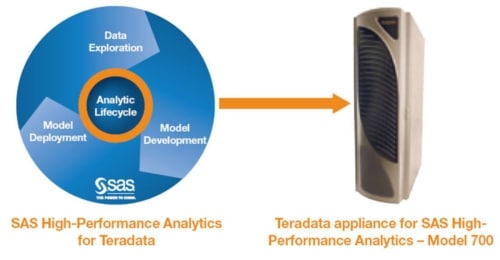 Teradata’s new Teradata 700 appliance is launching as part of an integrated offering, SAS High-Performance Analytics for Teradata, which uses in-memory analytics to distribute big data and data warehousing analytics in parallel across a pool of memory. The Teradata 700 is pre-loaded with SAS High-Performance Analytics and purpose-built to leverage SAS advanced analytics.
Teradata’s new Teradata 700 appliance is launching as part of an integrated offering, SAS High-Performance Analytics for Teradata, which uses in-memory analytics to distribute big data and data warehousing analytics in parallel across a pool of memory. The Teradata 700 is pre-loaded with SAS High-Performance Analytics and purpose-built to leverage SAS advanced analytics.
Teradata’s new Teradata 700 appliance is launching as part of an integrated offering, SAS High-Performance Analytics for Teradata, which uses in-memory analytics to distribute big data and data warehousing analytics in parallel across a pool of memory. The Teradata 700 is pre-loaded with SAS High-Performance Analytics and purpose-built to leverage SAS advanced analytics.

As the data storage industry responds to the increasing pace of data creation, rapid access to analytics can provide a competitive advantage at enterprise scales. Teradata’s High-Performance Analytics is designed for organizations want to make quicker assessments and decisions with their data or ones that regularly execute complex queries that are time-prohibitive with current-generation analytics systems. This kind of data analysis is essential in industries like telecommunications services, finance, and distributed retail operations.
The appliance features a Teradata hardware platform with dual Intel six core Westmere processors, and SUSE Linux operating system preinstalled. The Teradata 700 also comes with preloaded SAS software and the Teradata DBMS running on the same system. The appliance is a dedicated analytic platform and not a traditional Teradata data mart appliance.
Analytical Capabilities
The Teradata 700’s analytical capabilities include: spanning data exploration, model development and model deployment executed in-memory. Processing analytical models in-memory allows administrators to develop and deploy complex analytical models using complete data instead of a subset. SAS High-Performance Analytics for Teradata works to identify non-important variables, describe important relationships, and identify the important factors for subsequent models. High-Performance Analytics also offers centralized viewpoint capabilities, providing a centralized monitoring point for the entire data ecosystem.
